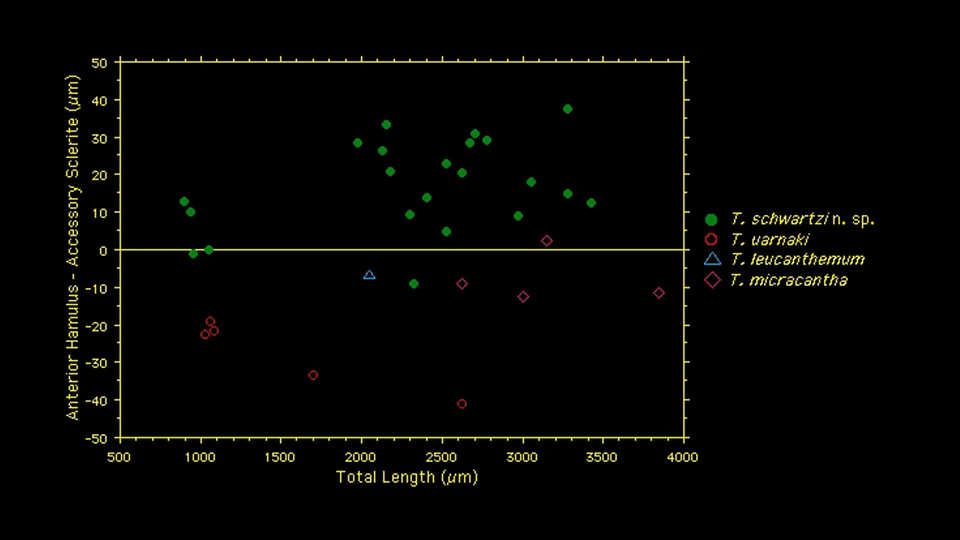William J. Poly
Research Associate
Department of Ichthyology
California Academy of Sciences
wpoly@calacademy.org
Return to William J. Poly's home page
Abstract
Trimusculotrema schwartzi n. sp. (Capsalidae) is described from the skin of the stingray, Dasyatis zugei (Elasmobranchii, Rajiformes, Dasyatidae) from Hong Kong, China. Only three other species have been placed in the genus Trimusculotrema: T. micracantha (Euzet and Maillard, 1967), T. leucanthemum (Euzet and Maillard, 1967), and T. uarnaki Whittington and Barton, 1990. Trimusculotrema schwartzi n. sp. may be differentiated from all known species of Trimusculotrema by the length of the anterior hamuli and by the absence of pigment shields over the eyes. Its occurrence on a stingray from China represents a northern extension of the geographic range of Trimusculotrema. [A fifth species, Trimusculotrema heronensis Whittington & Kearn, 2008, has been described recently; Whittington, I. and G.C. Kearn. 2008. Trimusculotrema heronensis sp. nov. (Monogenea, Capsalidae) from the skin of the pink whipray Himantura fai (Elasmobranchii, Dasyatidae) from Heron Island, Queensland, Australia. Acta Parasitologica 53(3): 251-257.]
Summary
Trimusculotrema schwartzi may be differentiated from all previously described species of Trimusculotrema in having anterior hamuli that are longer than the accessory sclerites in most cases (Fig. 14) and also differs from other T. spp. by the absence of pigment shields over the eyes (Table I). Trimusculotrema schwartzi differs further from T. leucanthemum by the shape and length of the accessory sclerites, which are 95 µm (48-140) in the former compared to 37 µm (32-42) in the latter and by the shape and length of the anterior hamuli, which are 114 µm (60-205) in the former compared with 30 µm in the latter. Furthermore, the haptor of T. schwartzi has three concentric muscle bands and no ribs at the periphery of the haptor, whereas the haptor of T. leucanthemum possesses only two concentric muscle bands and has radial ribs along the margin of the haptor. Trimusculotrema schwartzi may be further differentiated from T. uarnaki by the shape and length of the anterior hamuli, which are 114 µm (60-205) compared to 46 µm (44-52). The haptoral papillae of T. leucanthemum differ from those of the other three T. spp. in having a scalloped margin (illustrated in Euzet and Maillard, 1967). Trimusculotrema schwartzi also differs from T. micracantha as to the level of the vaginal opening, which is at the level of the oötype in T. schwartzi compared to the posterior level of the left anterior attachment organ in T. micracantha (however, note that this characteristic might have been affected by contraction).
The pair of raised structures at the anterior end of T. schwartzi might serve a sensory function (Fig. 11); similar structures were not observed by us on other T. spp. (the structures were visible with LM on most specimens of T. schwartzi). Thus, the structures might be unique to T. schwartzi. Benedeniella posterocolpa has a large conical papilla on each anterior attachment organ (McMahon, 1963; W. Poly and W. Dyer, pers. observ.) that also might be a unique sensory structure for this species (McMahon, 1963).
Share This
The Department of Ichthyology is home to one of the largest and most important collections of fishes in the world, and is designated as one of eight International Centers for Ichthyology in North America. Meet the researchers, explore projects and expeditions, and more.

